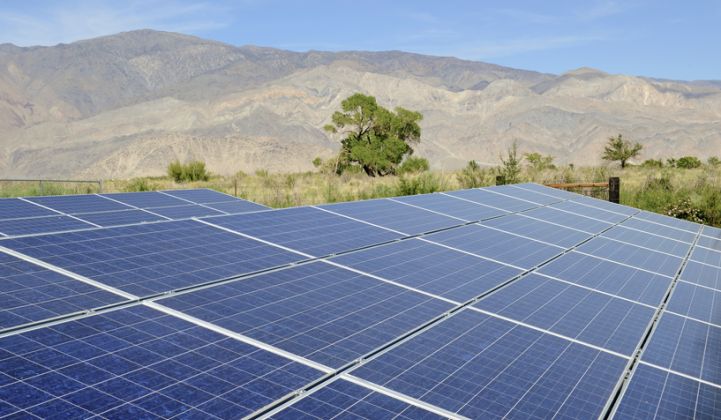Despite Mexico opening up its electric-power sector to private players, unclear rules are holding back installers and investors from tapping much of the country’s solar power potential.
Mexico's energy reforms, approved last year, are expected to bring up to USD$9 billion in investment in the electric power sector to 2019, according to the energy ministry. But investors and companies bemoan that red tape and regulatory uncertainty are hindering the sector’s growth.
GTM Research predicts that Mexico will lead Latin America in solar power generation by 2020, with the market likely to almost triple in size this year to 194 megawatts. The country’s solar energy association, ANES, announced this week it is targeting a total installed capacity of 3 gigawatts by 2025.
Progress is underway, with the government having set targets for renewables to account for 25 percent of power generated by 2018, 30 percent by 2021, 35 percent by 2024, and 60 percent by 2050 as part of the reform’s energy transition law.
Investment in the solar sector so far this year totals around USD$2.5 billion, while the number of solar companies operating in Mexico has leapt to around 600 -- a 1,200 percent increase from 46 in 2010, according to ANES.
But there are major hurdles to overcome for Mexico to harness its full potential, according to academics and local and international firms. Much of the frustration comes from the lack of information regarding regulations and tenders provided by state utility CFE and the energy regulatory commission (CRE).
“The mañana mantra is alive and well at the CFE,” said Don Walter, CEO of Sonora Energy Group, based in the northwestern city of Hermosillo, in an interview with GTM.
“The bigger concerns are not the timing or release of data, but with the CFE’s fumbling of the ‘qualified user’ definition, which is a major impediment to further development," said Walter.
He also expressed concern about the manipulation of commercial, industrial and residential electricity rates, which, as promised by the CFE late last year, have dropped month-on-month since January, but rose again in August.
“That does not give developers or investors confidence that they are dealing with something they can understand. And that’s a problem, and a risk that Mexico runs by overplaying its hand,” he said.
There is also uncertainty concerning how the clean energy certificates that Mexico's energy ministry plans to issue in 2018 will be traded.
“If you want to attract foreign investment, stability and confidence must be in place, and they are not,” Walter said.
Furthermore, the design of many buildings makes them inadequate for solar panel installation.
“If we really want to harness power from solar panels, we need to move toward the construction of electricity network infrastructure or autonomous micronetworks operating on direct current," said Arturo Morales-Acevedo, an academic at the national polytechnic’s advanced research and study center, speaking to the state news agency in July.
Cost is still a major barrier as well. The investment required to install a 2-kilowatt-capacity solar array is around $4,000 to $5,000 -- a price tag beyond the reach of many households. Apartment buildings, where the majority of people in the capital and other large cities live, are not able to support solar arrays large enough to power all the residences, said Morales-Acevedo.
Finally, the regulation of solar electricity sales are still in flux.
“The CFE [Federal Electricity Commission] has yet to develop an understanding of the sector,” said Juan Pablo López, corporate director of Mexico-based PV solutions firm Bioenergy.
Fiscal incentives are in place, including a 20 percent discount on property tax for residences generating more than 50 percent of their power needs. Companies using solar also receive a tax break on payrolls and water tariffs, making PV technology more accessible. But the lack of clear rules means that "one cannot yet sell electricity to the CFE," said López.
Despite the uncertainty, American and European solar companies are eyeing Mexico’s potential. In May, French solar tracker manufacturer Exosun signed a supply contract with Mexican PV developer Forza to build a pilot plant in the northwestern state of Sonora. And California-based SolarCity in August acquired Mexican rooftop solar developer ILIOSS.
“Mexico's combination of high electricity rates, favorable solar economics and massive solar resources makes it one of the most promising solar markets in the world," SolarCity said at the time.
Domestic firms are also starting to ramp up. Mexican firm ErgoSolar said in July it plans to invest $15.8 million in new residential and small business projects in the country.
The states currently seeing the heaviest investment in solar are Baja California, Baja California Sur, Chihuahua, Jalisco and Sonora.
***
Join GTM for Solar Summit: Mexico in January. Learn more here.



